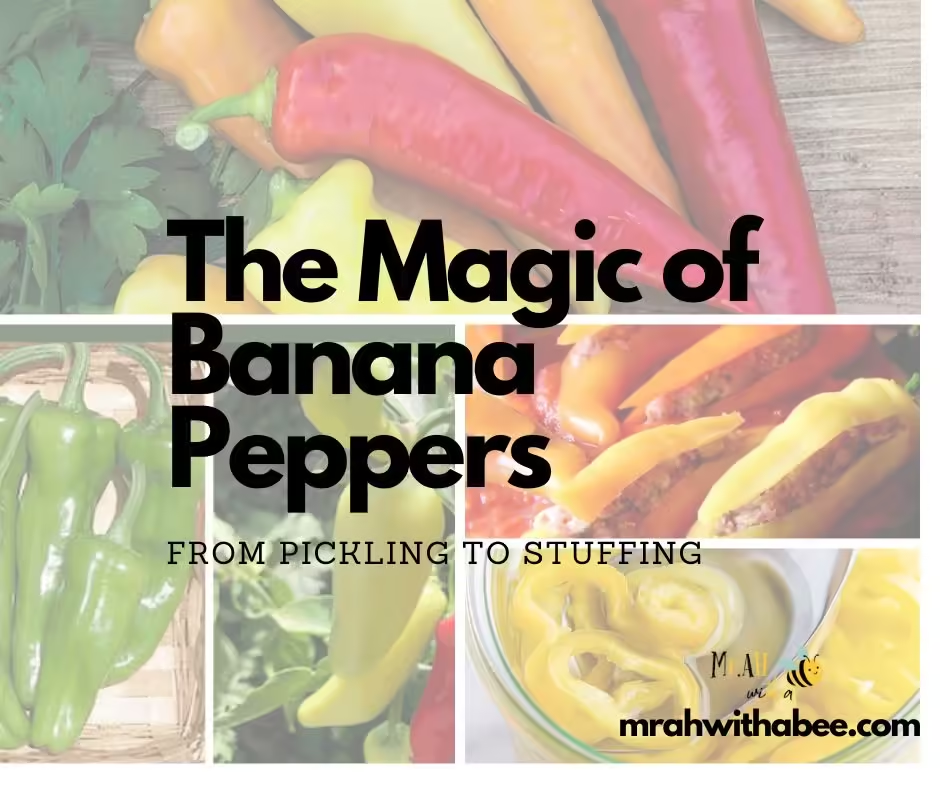Banana peppers are mild and tangy flavored, yet they are popular for adding color and taste to salads, sandwiches, and pizzas. Their exceptional taste and versatility make them famous in many kitchens. This guide covers several ways to use banana peppers, their nutritional benefits, preparation tips, and creative ways to pickle them with added spice.

What are Banana Peppers
Banana peppers are typically yellow, green, or red and have a mild, tangy flavor. Their prolonged and curved shape resembles that of bananas, which is how they got their name. These peppers are a popular choice in various dishes due to their slightly sweet flavor and low heat. They are commonly used in salads, sandwiches, and pizzas, they can also be pickled and stuffed. Pickling extends its shelf life. They are a rich source of vitamins and minerals, and adding them to our diet can contribute to nutritional benefits.

Pickled Banana Peppers
A great way to preserve the flavor of peppers and add zest to meals is by pickling them. The pickling process involves soaking sliced peppers in vinegar-based brine, to enhance their tanginess and extend their shelf life. These pickled peppers can be added to salad, sandwiches, tacos, or burgers for an extra kick.
- Storage Tips: Pickled peppers can be stored in an air-tight jar in the fridge. They can last up to six months if sealed and stored properly.
- Benefits: Pickled peppers contain probiotics that support gut health and digestion. Pickled banana peppers are high in vitamins, particularly vitamin C, which is essential for immune function and skin health. The fermentation process enhances the antioxidant properties of the peppers, helping to combat oxidative stress in the body. The fermentation process can introduce beneficial bacteria, promoting gut health and aiding digestion. Ingredients in the pickling solution, such as ginger and garlic, can help strengthen the stomach and relieve discomfort.

Stuffed Banana Peppers
Stuffed peppers are delicious and can be filled with a variety of ingredients including cheeses and ground meats to rice and vegetables. This creates a balance with the flavor of the filling and brings out the sweetness of peppers.
- Cooking Methods: They are best when baked or grilled for a soft, melty, and slight char on the outside.
- Serving Suggestions: They can be served as a side dish with grilled meats, or pair them with marinara sauce and salsa.

Banana Peppers vs. Pepperoncini
Due to their similar appearances, banana peppers and pepperoncini are often mistaken for each other. The key differences between peppers and pepperoncini are:
- Appearance and Flavor: While both peppers are yellow-green, banana peppers have a sweeter taste and are typically milder Pepperoncini peppers have a slightly bitter taste.
- Heat Levels: Banana peppers have a Scoville Heat Unit (SHU) rating of 0 to 500 (Caterina et. al., 2016), making them very mild, whereas pepperoncini range from 100 to 500 SHU (Guzman et. al., 2011).
- Culinary Uses: Pepperoncini adds tangy heat to Greek salads and sandwiches, while banana peppers are ideal for salads and mild salsas.
Are Banana Peppers Spicy?
They are known for their mild heat level between 0 to 500 on the Scoville Heat Unit (SHU) scale. Most people find them mildly tangy with a hint of kick, making them a good choice for those who prefer a gentle spice. However, many factors can influence their spiciness. The ripeness of the peppers plays a key role as banana peppers mature, their heat may increase and their flavor can become slightly sweeter. The way they are prepared, whether raw, roasted, or pickled can also affect their overall heat level. For instance, roasting may enhance their sweetness while mellowing out any residual spiciness.
Are Banana Peppers Good for You?
These peppers can offer several health benefits:
- Nutritional Benefits: High in vitamins A, C, and B6, along with fiber and minerals, they support immunity, skin health, and metabolic functions.
- Vitamin C: Acts as an antioxidant, supporting immune function and skin health (Mendes & Gonçalves, 2020).
- Vitamin A: Present in the form of carotenoids, it is essential for vision and immune health (Afolayan et. al., 2020).
- Health Benefits: Their fiber content promotes digestion, while antioxidants help protect against cellular damage. Plus, they’re low in calories, making them a great addition to many diets.
- Considerations: Some people may be allergic to these peppers, though allergies are relatively rare.
How to Pickle Banana Peppers and Make Them Hot
Adding some spice to pickled peppers is a great way to enhance their flavor. Follow this step-by-step guide for a deliciously spicy result!
Ingredients:
| Fresh banana peppers | One pound |
| Vinegar | One cup |
| Water | One cup |
| Pickling salt or Kosher salt | 1 to 2 tabelspoons |
| Spicy peppers (e,g jalapeños) | sliced or whole |
| Garlic cloves | 2 to 3 (optional) |
| Whole peppercorns | 1 teaspoon (optional) |
| Bay Leaf | 1 (optional) |
Prepare the Peppers
- Wash the peppers thoroughly.
- Slice them into rings or leave them whole, depending on your preference.
Make the Brine
- In a pot, combine 1 cup vinegar and 1 cup water.
- Add 1-2 tablespoons of salt and 1 tablespoon of sugar (if desired).
- Bring the mixture to a boil, stirring until the salt and sugar are dissolved.
Add Spice:
- In a clean jar, layer the sliced peppers.
- Add 1-2 spicy peppers (like jalapeños) or a pinch of chili flakes for added heat.
Flavor the Brine:
- Add 2-3 garlic cloves, 1 teaspoon of whole peppercorns, and 1 bay leaf for additional layers of flavor.
- Pour the hot brine over the peppers, ensuring they are fully submerged.
Seal and Store:
- Seal the jar tightly with a lid.
- Allow the jar to cool to room temperature before refrigerating.
Let Them Pickle:
- Let the pickled peppers sit in the refrigerator for at least 24 hours to get the best results The longer they sit, the more flavorful they will become!
Storage Tips: Keep spicy pickled peppers in the fridge for up to six months.
Conclusion
Banana peppers offer a sweet, mild flavor that’s easy to incorporate into dishes. They are versatile and nutritious, whether pickled, stuffed, or used fresh, they add unique flavor and color to meals. Experimenting with pickling and stuffing allows you to enjoy banana peppers in various forms, and their health benefits make them a great addition to a balanced diet.
FAQs
How do I pickle peppers?
Slice the peppers, prepare a vinegar-based brine, and pour it over them in a jar. Refrigerate for 24 hours.
Can I freeze banana peppers?
Yes, freezing is a great way to preserve them. Slice, flash freeze, and store in a freezer bag.
Are banana peppers and pepperoncini the same?
No, they differ in flavor and heat level; pepperoncini are slightly spicier.
What dishes can I make with banana peppers?
Use them in salads, sandwiches, stuffed with cheese or meat, or add to pizzas and tacos.
How long do pickled peppers last?
When refrigerated, pickled peppers can last up to six months.
Can I use banana peppers in salsa?
Yes, they add a mild flavor and subtle sweetness to salsa.
How can I add heat to pickled peppers?
Include a hot pepper or chili flakes in the brine to add spiciness.
Are banana peppers high in calories?
No, they’re low-calorie, making them a healthy addition to many meals.
What’s the difference between banana peppers and jalapeños?
Jalapeños are much hotter, scoring 2,500–8,000 SHU, while banana peppers are mild.
Can I use peppers in soups?
Yes, they add flavor and color to soups, especially when used in vegetable or chicken soups.
Thank you for reading, for more interesting articles, visit our homepage



